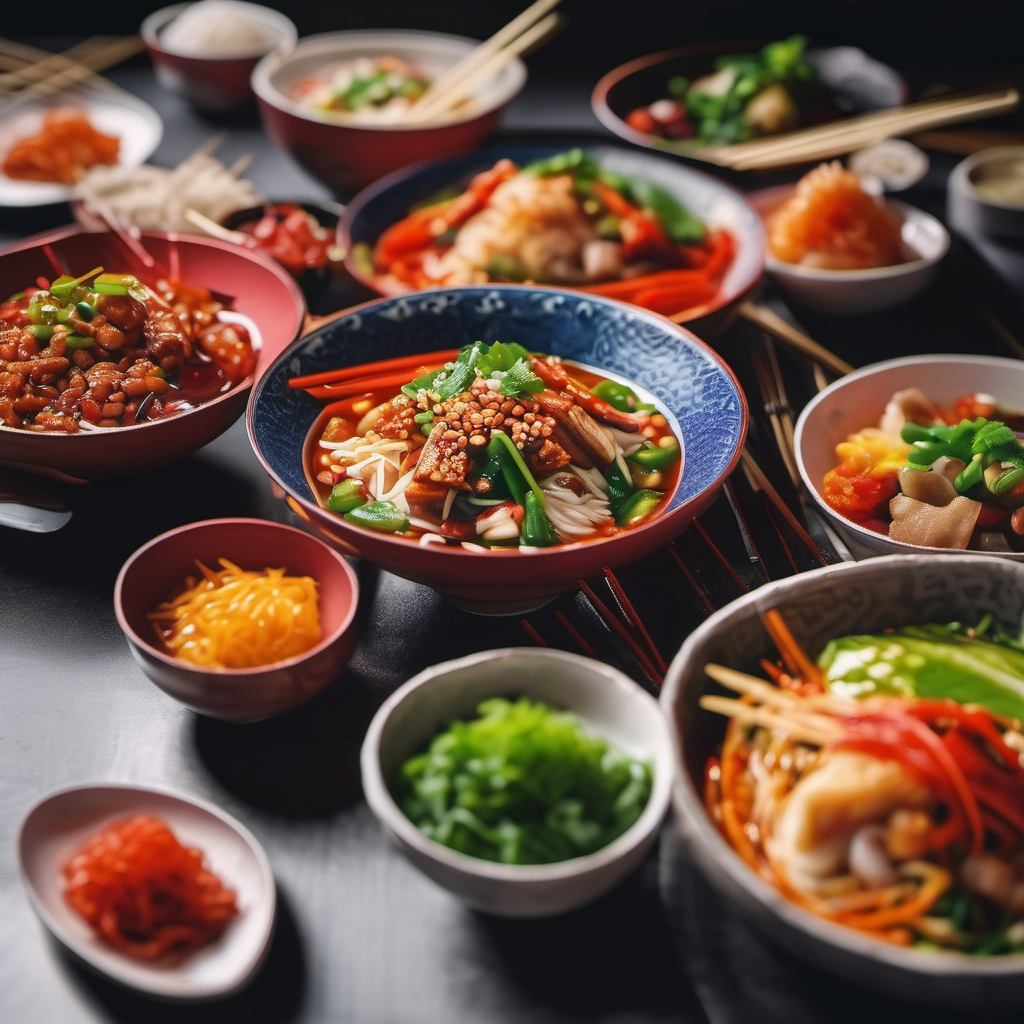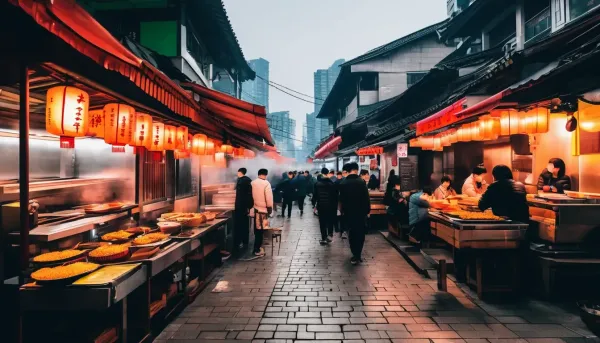Culinary Delights Across China: Regional Representations of Chinese Cuisine
Exploring China's regional cuisines is not just about food—it's a journey through history, geography, and the rich tapestry of Chinese culture.

China, a vast and diverse country, boasts a culinary landscape as varied as its geography and culture. From the hearty dishes of the Northeast to the spicy flavors of the Southwest, each region offers unique delicacies that reflect local traditions, ingredients, and historical influences. Let's embark on a gastronomic journey through China's major regions—Northeast, Northwest, North China, Southwest, Southeast, and East China—to explore their iconic dishes and culinary heritage.
1. Northeast China (东北)
Representative Cuisine: Dongbei Dumplings (东北饺子)
Northeast China, known as Dongbei, is characterized by its harsh winters and fertile plains, which influence its hearty and warming cuisine. One of the most iconic dishes from this region is Dongbei Dumplings, or "Dongbei Jiaozi." These dumplings are larger and heartier than their southern counterparts, typically filled with a mixture of minced pork, cabbage, and sometimes shrimp or other seafood. They are often served with a dipping sauce made of soy sauce, vinegar, and chili oil, adding a punch of flavor to each bite.
Other notable dishes from Northeast China include:
- Guo Bao Rou (锅包肉): Sweet and sour pork, where the pork is crispy fried and coated in a tangy sauce.
- Stewed Pork with Vermicelli (红烧肉炖粉条): A comforting dish where pork belly is stewed with vermicelli noodles in a savory broth.
2. Northwest China (西北)
Representative Cuisine: Xinjiang Lamb Skewers (新疆羊肉串)
Northwest China, encompassing Xinjiang, Gansu, Ningxia, Qinghai, and Shaanxi provinces, is characterized by its Muslim influences and vast, arid landscapes. Xinjiang Lamb Skewers are a beloved street food across China, originating from the Uighur cuisine of Xinjiang. Tender chunks of lamb or mutton are marinated with cumin, chili flakes, and other spices, then grilled over charcoal until charred and smoky. They are typically enjoyed with flatbread (naan) and a refreshing yogurt drink.
Other notable dishes from Northwest China include:
- Hand-Pulled Noodles (拉面): Thick, chewy noodles served in a hearty lamb or beef broth, often garnished with cilantro and chili oil.
- Liang Pi (凉皮): Cold skin noodles made from wheat or rice flour, dressed in a tangy vinegar and chili sauce, topped with julienned cucumber and bean sprouts.
3. North China (华北)
Representative Cuisine: Beijing Roast Duck (北京烤鸭)
North China, centered around Beijing and Tianjin, is known for its wheat-based dishes and imperial culinary traditions. Beijing Roast Duck, or "Peking Duck," is perhaps the most famous dish from this region. The duck is specially bred and roasted until the skin is crispy and golden, while the meat remains tender and flavorful. It is traditionally served with thin pancakes, spring onions, cucumber, and hoisin sauce, allowing diners to assemble their own wraps.
Other notable dishes from North China include:
- Zhajiangmian (炸酱面): Wheat noodles topped with a savory, minced pork sauce cooked with fermented soybean paste and fresh vegetables.
- Tianjin Goubuli Baozi (狗不理包子): Steamed buns filled with a juicy mixture of minced pork and spices, originating from Tianjin.
4. Southwest China (西南)
Representative Cuisine: Sichuan Hot Pot (四川火锅)
Southwest China, particularly Sichuan province, is renowned for its bold and spicy flavors, thanks to the liberal use of Sichuan peppercorns and chili peppers. Sichuan Hot Pot is a communal dining experience where diners cook a variety of ingredients, such as thinly sliced meat, seafood, tofu, and vegetables, in a simmering pot of flavored broth. The broth itself is intensely flavored with spices, creating a numbing and spicy sensation known as "mala."
Other notable dishes from Southwest China include:
- Mapo Tofu (麻婆豆腐): Soft tofu cubes cooked in a spicy, chili and bean-based sauce with minced pork.
- Dandan Noodles (担担面): Noodles topped with spicy minced pork sauce, Sichuan peppercorns, and often garnished with preserved vegetables.
5. Southeast China (东南)
Representative Cuisine: Cantonese Dim Sum (广东点心)
Southeast China, centered around Guangdong province (Canton), is known for its delicate and flavorful Cantonese cuisine, characterized by fresh seafood and subtle flavors. Cantonese Dim Sum refers to a variety of small dishes traditionally served with tea, encompassing dumplings, buns, rolls, and pastries. Popular dim sum items include Har Gow (shrimp dumplings), Siu Mai (pork dumplings), Char Siu Bao (barbecue pork buns), and Egg Tarts.
Other notable dishes from Southeast China include:
- Cantonese Steamed Fish (清蒸鱼): Fresh fish steamed with ginger, spring onions, soy sauce, and a splash of hot oil.
- Wonton Noodle Soup (云吞面): Thin noodles in a clear broth with wontons filled with minced pork and shrimp, garnished with leafy greens.
6. East China (华东)
Representative Cuisine: Shanghai Xiaolongbao (上海小笼包)
East China, particularly Shanghai and neighboring Jiangsu and Zhejiang provinces, is known for its freshwater ingredients and delicate flavors. Shanghai Xiaolongbao are small, steamed buns filled with hot, savory broth and minced pork. The buns are delicate and require skill to make, with a thin skin that holds in the flavorful soup until you bite into it. They are typically enjoyed with vinegar and thinly sliced ginger.
Other notable dishes from East China include:
- Jiangsu Lion's Head Meatballs (江苏狮子头): Large pork meatballs cooked with cabbage in a savory broth, symbolizing prosperity and good fortune.
- Hangzhou West Lake Fish in Vinegar Sauce (杭州西湖醋鱼): Sweet and sour fish fillets served in a delicate vinegar sauce, a specialty from Hangzhou.
Conclusion
Chinese cuisine is not only diverse but also deeply rooted in local traditions, ingredients, and cultural influences. Each region offers a distinct culinary experience, from the robust flavors of the North to the spicy and numbing dishes of the Southwest, and the delicate flavors of the Southeast and East. Exploring China's regional cuisines is not just about food—it's a journey through history, geography, and the rich tapestry of Chinese culture. Whether you're savoring Dongbei Dumplings in the Northeast or enjoying Shanghai Xiaolongbao in the East, each bite tells a story of centuries-old culinary craftsmanship and innovation. Embrace the flavors, indulge in the diversity, and immerse yourself in the culinary treasures that China has to offer.



